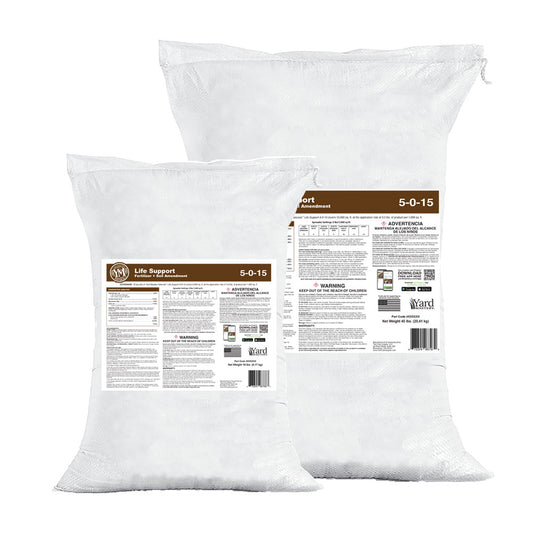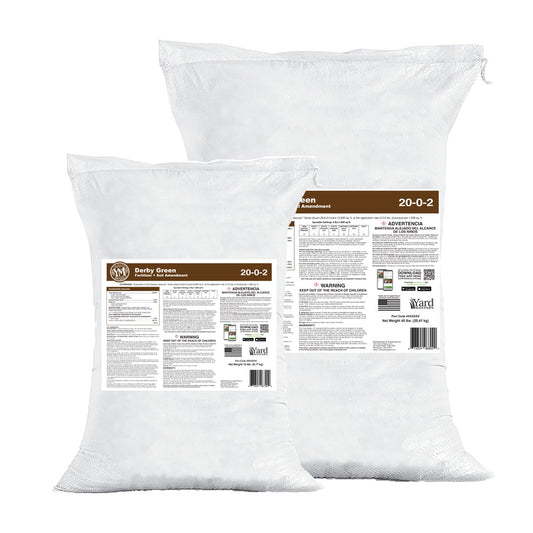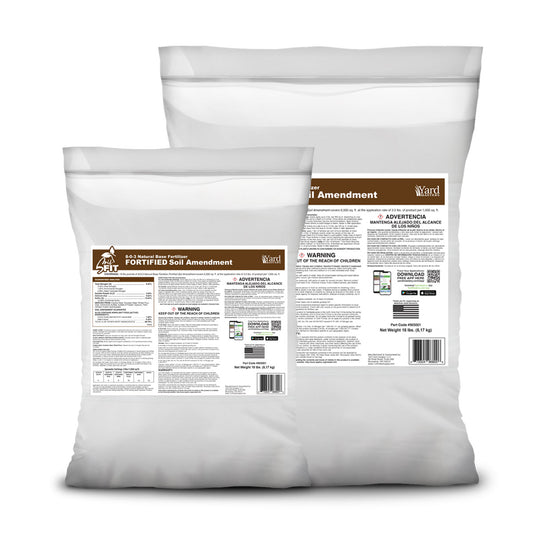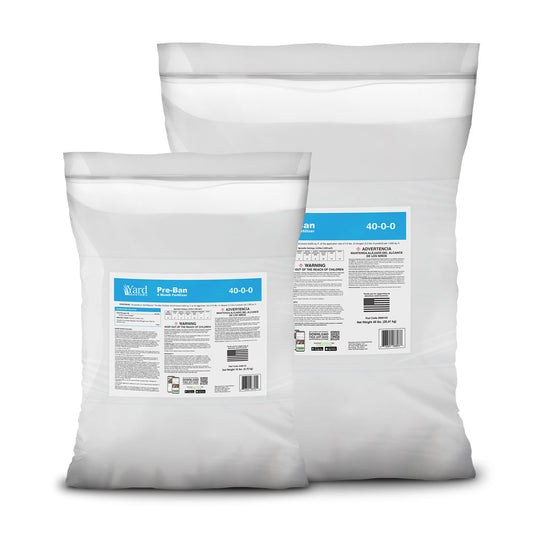The Crabgrass Guide
How To Identify Crabgrass
Crabgrass (genus: Digitaria) is one of the primary pests that infests lawns across the United States. Cool season lawns as far north as the Dakotas, down through the Midwest over to the northeast, and all the way down to South Florida can have problems with it.
Crabgrass is classified as an annual grassy weed. “Annual” means that plants grow from seed, live for a single season, and die, never to return. Doesn’t sound too serious, does it?
The thing about it is that just before its short season of life is over, crabgrass drops thousands of seeds that fall all around it, get into the soil, and germinate and grow the following season. A crabgrass infestation that is left untreated can take over an entire lawn in just a couple of seasons. Some folks have lawns that are 100% crabgrass, and they don’t even know it! All they know is that their lawn looks terrible in early spring, comes in strong in summer, and then seems to fade quickly when fall temps cool off.
Looking at the genus of crabgrass, Digitaria, what word in there is familiar? See “digit?” In human anatomy, what is a digit? It’s a finger. In the case of crabgrass, this is descriptive of the growth habit of crabgrass in that it “fingers” out across the lawn, creeping, like a crab.
Let’s just pretend for a minute, there is one single crabgrass seed in your lawn, here is how it will live it’s life and spread its destructive offspring.
In the early spring, as soil temps approach 55F, the seed will begin to awaken and will germinate sometime between the soil temperatures of 55 and 70. Some crabgrass seeds are early, others late but that is the germination window, 55F - 70F.
Now you won’t see this baby crabgrass plant at this point, it takes it a few weeks to actually grow large enough to poke up through the canopy of your existing lawn. In most cases, you, the homeowner, won’t actually see any crabgrass until mid summertime.
Once that crabgrass plant sees sunlight, that’s when it takes off. It spreads out wide, pushing your good grass to the side, competing for space, and winning. It will spread wider and wider all during the summer and into fall. This spreading is called “tillering,” and those crabby digits tiller like crazy during the hot months of the year.
Then, in the fall time, as outside temps begin to move to a more mild state, and along with them, soil temps come down, the crabgrass will produce prolific amounts of seed on little stalks.
As winter comes closer and closer, and you get your first good cold snap, maybe even a little frost, that cold triggers our mature crabgrass plant to drop those seeds all around itself. Soon after, it turns purple and dies.
All those widespread, fat digits from the mother plant then decay, shelter, and feed the new seeds, which literally “chill in the soil” until the following spring when the process starts all over again as soil temperatures once again approach that 55°F mark.
As I mentioned above, now there are thousands of seeds sitting there just waiting to crab out in your lawn. One crabgrass plant can produce 100,000 or more seeds in a single season, and that is how the problem can get so bad, so fast!
Why Cutting Your Lawn Short Won't Stop the Crabgrass Takeover
Now you might be thinking, “I’ll just mow my lawn extra short and nip this problem in the bud.” Unfortunately, crabgrass laughs in the face of low mowing. Thanks to those sneaky, finger-like stems we talked about earlier, crabgrass hunkers down close to the soil, spreading itself out like a bad case of bed head.
Even if you set your mower as low as it will go, crabgrass is perfectly content to send out seeds practically hugging the ground—sometimes even at heights lower than you’d ever mow your good grass. Meanwhile, your desirable turfgrass will be stressed and scalped, but the crabgrass just shrugs and keeps on multiplying.
Bottom line? No matter how short you cut, those crafty crabgrass plants will keep ducking under your mower blades, producing seeds right up until that first cold snap sends them packing for the year. So if you thought ultra-short mowing was the secret weapon, crabgrass is already one step ahead.
How to kill crabgrass
Now that you know what crabgrass is and how it grows and lives, you can formulate a plan to eliminate it from your lawn. And the first thing I want to say about getting rid of, or killer crabgrass, is that it’s an ongoing strategy. In other words, there is no “one and done” miracle cure for crabgrass. It’s a strategy you will want to employ over time.
The good news here is, though, that you can see results quite quickly if you start at the right time and that means starting in the spring with a pre-emergent herbicide to stop those seeds from seeing the light of day, literally.
A pre-emergent herbicide is a product that you apply to the lawn BEFORE the crabgrass seeds germinate, and it stops them. What it does is create a vapor barrier in the top few centimeters of the soil so that when the young crabgrass plant germinates the vapor kills it by disrupting cell division. That’s the scientific explanation but for you, you just have to look at it like you are putting down a barrier against the crabgrass, stopping it from growing in your lawn.
Why Most Weed & Feed Fertilizers Miss the Mark
Now, you might be asking yourself, “Why can’t I just toss down one of those weed & feed fertilizers and be done with it?” Well, here’s the thing: crabgrass is technically a grass, not a broadleaf weed like dandelion or clover. Most weed & feed products on the shelves are designed to target broadleaf weeds only. Their selective herbicides—the ones mixed in with the fertilizer—are tuned to attack and knock out non-grassy culprits while leaving lawn grasses unharmed.
That means, even if you follow the directions perfectly, those weed & feed products won’t make a dent in crabgrass. The crabby foe slips right through because, to the herbicide, it looks just like the good grass you’re trying to protect. If you want to put a real stop to crabgrass, you’ll have to reach for a targeted pre-emergent, not the broadcast broadleaf solutions.
Pre-Emergents
Several products on the market can act as pre-emergents.
When searching for pre-emergent for crabgrass, you want to look at the active ingredient. The two most common ones you will find are prodiamine and dithiopyr. These are the gold standard pre-emergents used against crabgrass, and you will find professional lawn companies using them as well as DIYers like yourself. The VERY same chemicals the pros use are available to us DIYers.
If you want my advice for the best pre-emergent to use for crabgrass, it’s prodiamine. This is because it is available in granular and liquid form so you can apply it with the method that you are most comfortable with. It’s also affordable and available in small quantities for the individual lawn owner like yourself.
If you want to use dithiopyr, it will work just as well but is oftentimes slightly more expensive, especially in liquid forms.
Which Pre-Emergents work best?
I get that question all the time, and the answer is the one that you can make the most consistent application with. If you are better at spreading granular products with a broadcast spreader, then that is the best crabgrass pre-emergent control to use. If you are better at spraying liquids from a pump/battery sprayer or hand can, then that is the best control for you. The key is to get the application down consistently according to the directions and to get it applied BEFORE the crabgrass germinates in spring.
When to Apply Crabgrass Pre-Emergents like Prodiamine?
You want to apply the prodiamine to the lawn as soil temperatures are approaching 55F in the soil. If you live up north then that is typically about the same time you see the forsythia blooming as they are triggered at about that same soil temperature. If you see the red bud trees flowering, that is another key sign that it’s time to apply your prodiamine to stop the crabgrass for the season.
If you want a more exact measurement of your soil temperatures, we have created a Free Lawn Care App that will give you the soil temperatures of your lawn, right down to the sidewalk level. We use the same technology that farmers use, and it’s very accurate. The app will even notify you when it’s time.
Once you apply your prodiamine, you want to water it in. It will not work if it can’t get into the top few centimeters of soil so be sure that you water it in with at least ½” or irrigation or since we get rain in the spring, that can do it too. When crabgrass pre-emergents fail, it’s usually because they did not get watered in properly.
Using Crabgrass Preventers Without Hurting New Grass Seed
One important thing to remember when using a crabgrass preventer is that these products don’t just block crabgrass—they stop most seeds from germinating, including your desirable lawn grasses. If you plan to overseed or repair areas in your yard, be strategic about timing.
- Here’s my best advice:
Always check the label instructions for any specific guidelines, but as a rule of thumb, wait at least 60 days after applying a pre-emergent before seeding your lawn. - It’s also a good idea to hold off on seeding until you’ve mowed your existing grass at least twice following the application. This ensures the barrier has broken down enough for new seedlings to establish properly.
By following these steps, you’ll keep crabgrass at bay without unintentionally blocking those fresh blades you want to see.
Crabgrass Killer
Now, if you missed your spring window for applying pre-emergent and you are looking at crabgrass that has grown, then you need a different strategy. Also, for those of you who do apply pre-emergent for crabgrass, please be ready for some “escapees” that get through the barrier. Remember, we are dealing with nature here, so nothing is going to be perfect.
In fact, if you do apply your pre-emergent on time and perfectly but have had major issues with crabgrass in the past, you for sure will have some breakthrough, especially around the edges of the lawn where grass meets sidewalk for driveway. These areas tend to heat up quickly and also get more foot traffic that will break down your crabgrass barrier.
In these cases, you need a crabgrass killing product that is known as a “post-emergent herbicide.” Post-emergent refers to the fact that you are killing crabgrass that has already germinated and grown. See how that works? “Post-emergent” means “killing crabgrass after it has come up.”
Now this one is going to vary just a little bit by grass type. Above, when I talked about prodiamine and dithiopyr, those pre-emergents can be used safely on all grass types. But with post-emergents, we have much less flexibility, and if you use the wrong crabgrass killer, you could damage your good turf. I’m not telling you this to scare you! But I am telling you this so you should be sure to read the label on the crabgrass killer you buy. I’ll give you the names of active ingredients and/or brand names to look for based on grass type.
Selective vs. Non-Selective Herbicides: Know the Difference
Before you grab just any bottle off the shelf, let’s talk about selective vs. non-selective herbicides. Selective herbicides are designed to target specific weeds or plant types—think grassy plants versus broadleaf plants—while leaving your desirable turfgrass unharmed. On the other hand, non-selective herbicides don’t discriminate; they’ll take out everything green, including your precious lawn and anything else that happens to be in the spray zone. So, unless you’re looking to start over with bare dirt, stick with selective, post-emergent herbicides for crabgrass.
Why "Weed & Feed" Usually Won’t Cut It
Because crabgrass is a grass, your standard weed & feed products (which are engineered to target broadleaf weeds like dandelions) won’t touch it. They’re great for cleaning up clover or chickweed, but won’t make a dent in crabgrass that’s already invaded your lawn. For that, you need a post-emergent product specifically labeled for crabgrass control.
Read the Label—Seriously
Always, always check the product label to make sure it’s safe for your specific lawn type. Some grasses, such as centipede or St. Augustine, can be sensitive to certain herbicides that are perfectly fine for bluegrass or fescue. The label will tell you which grass types are approved and what weeds the product will control. Follow label instructions closely—not just for best results, but for the safety of your lawn, your pets, and your family.
With that out of the way, let’s talk specifics—active ingredients and recommended products for different types of grass.
Selective vs. Non-Selective Herbicides: What’s the Difference?
Before we jump into the specific products, let’s quickly clear up an important detail when it comes to choosing crabgrass killers: the difference between “selective” and “non-selective” herbicides.
A selective herbicide is designed to specifically target unwanted weeds like crabgrass, leaving your desirable lawn grasses unharmed, as long as you follow the label instructions. These are your lawn’s best friends when you want to take out the bad guys without hurting the good ones.
On the other hand, non-selective herbicides don’t discriminate. They’ll take down pretty much any green plant they touch—crabgrass, your prized lawn, and even Grandma’s petunias if you’re not careful. Think of non-selective herbicides as the “scorched earth” approach. You’ll usually only want to use these on areas like sidewalk cracks or driveways where you don’t want anything growing, period.
Always double-check which type you’re reaching for, especially if you value that thick, green carpet you’ve worked so hard to grow.
Recommended Crabgrass Killers
Quinclorac For Crabgrass
For cool season lawns: Kentucky Bluegrass, perennial ryegrass and turf type tall fescue, and also warm season grasses zoysia and bermuda, the active ingredient you want to look for is quinclorac.
Quinclorac works great on crabgrass that is newly emerged up to the 3 tiller stage. This means if you notice crabgrass in midsummer or earlier, quinclorac will work great to kill it. It turns the crabgrass a red-orange color within 4-5 days.
For these grass types, quinclorac is your first and best choice because it works and it’s inexpensive. Currently, the smallest quinclorac bottle you can get is a “dry flowable,” which is essentially a particulate powder, and it comes in a 1 lb size. The thing to note here is that this 1lb jug will be enough to cover 1 acre or 43,500 sq ft. Just think about that for a minute so it sinks in. You will spend around $50 for that 1lb of quinclorac, and if you have a normal-sized residential lawn of around 7,000 sq ft, that jug will give you more than 6 applications.
Now keep in mind, you are not going to have to blanket spray your entire lawn for crabgrass! At least let’s hope not, but even if you did, you can usually kill crabgrass with one, maybe two applications so you would have enough for 3 or 4 years of treatments. That makes it easier to stomach that $50 cost doesn’t it?
Tenacity herbicide for Crabgrass
Tenacity is a very well-known post-emergent herbicide that is used against several different weeds. It’s good on crabgrass, especially if it's become a little more mature. Tenacity will turn crabgrass white.
Tenacity is a brand name, and the active ingredient is mesotrione. These days, you do not have to pay full price for the brand “Tenacity” and can instead get an exact match generic called Meso 4SC.
Mesotrione (Tenacity) can be used on Kentucky Bluegrass, Turf Type Tall Fescue, Perennial Ryegrass and centipede grass. However it is NOT the best choice if you have crabgrass in your centipede. It’s good for the cool season grasses though and can be used to control other weeds as well.
Celsius Herbicide for Crabgrass
My number one choice for killing crabgrass in warm season turf, St Augustinegrass, bermuda, zoysia and centipede is Celsius® WG Broadleaf and Grassy Weed Control. It’s one of the very best all around post emergent weed controls for these grass types. It also does quite well as a crabgrass killer.
Another reason I like Celsius herbicide is that it can be sprayed when temperatures are high. Many weed controls have temperature restrictions where you cannot spray them if the air temps are over 85F which in the south in summer is pretty much everyday. Crabgrass shows up in summer when it’s hot and this makes Celsius perfect because you don’t have to be concerned with the high temperatures.
This is another one of those herbicides that is going to seem expensive when you see the price, but once again, this being a professional formulation, that bottle will cover well over an acre, so you’d get several applications over a number of years with one bottle.
Now let me tell you, there are many other herbicides available that will kill crabgrass, but the ones I listed here are the most accessible to homeowners, and they work. That is why I recommend them.
Stopping Crabgrass - The Dual Approach Since we have come this far, let me take you through a complete strategy for eliminating crabgrass in a lawn. Remember, you can also download our free pre-emergent guide that takes you through some of this step by step and in great detail but I’ll also give you the basics here.
The key is to use a good pre-emergent and post-emergent strategy to stop crabgrass. With this strategy, you can eliminate a bad problem in 2-3 years in most cases. However, it’s always going to be important to keep up with pre-emergents even after that point because some of the crabgrass seeds can lie dormant in the soil for 10 years or more, and if we get a wet spring, they can wake them up from the deep! But again, 2-3 years using the strategy below will eliminate almost all your crabgrass problems.
- Early spring, as soil temps approach 55°F - Pre-emergent application
- Mid-spring, as soil temps approach 65F - Pre-emergent application
- Summer - spot spray any escapees with post-emergent herbicide
- Late Summer/Fall - continue spot spraying escapees with post-emergent.
That is all you have to do to kill the crabgrass in almost any lawn. It’s not a one and done prospect and it takes time, but it can be done and thousands of our customers have had great success.
- Choosing a selection results in a full page refresh.





